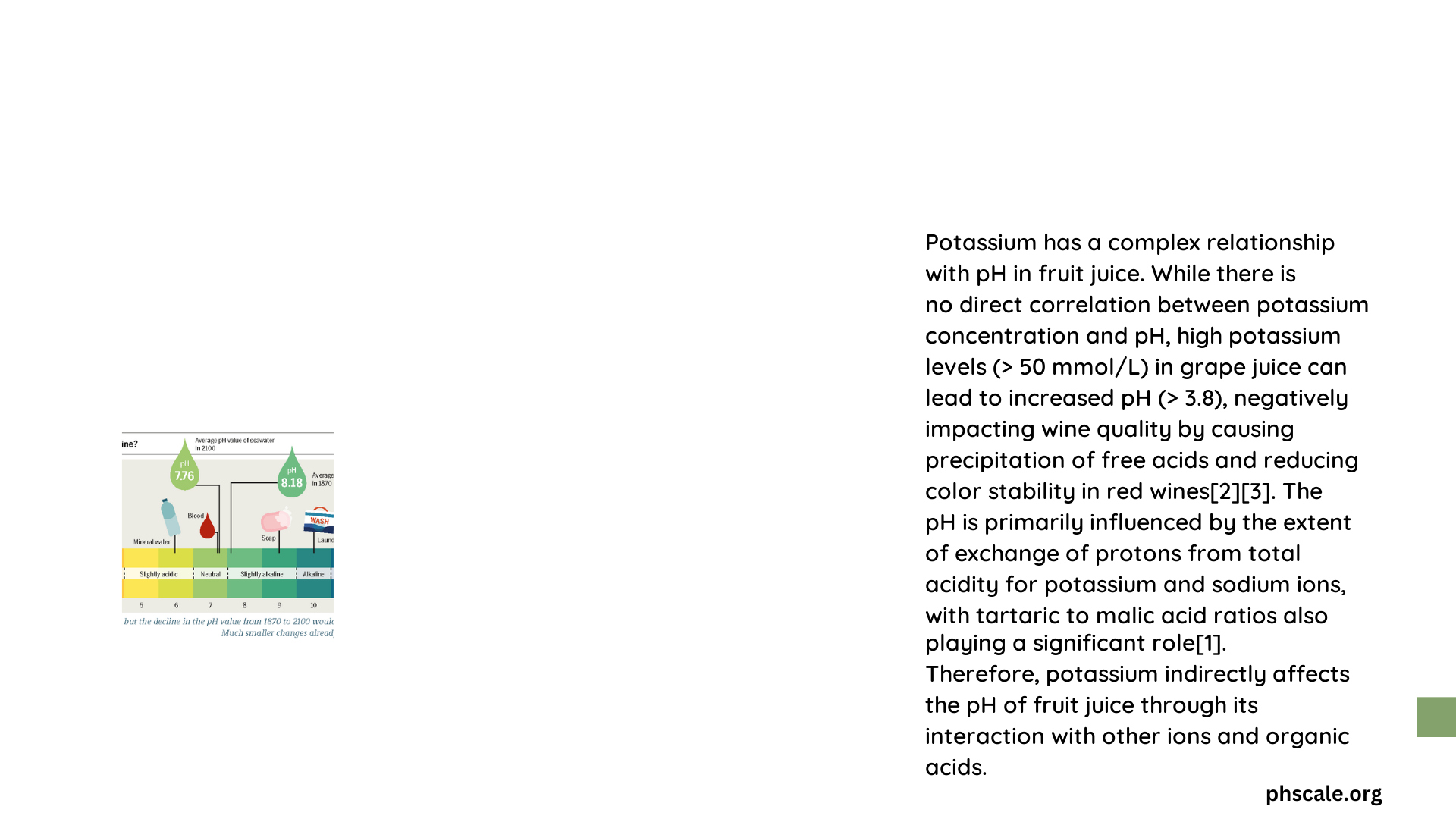Potassium significantly affects the pH of fruit juices, particularly in grape juice. High potassium concentrations can lead to increased pH levels due to the precipitation of free acids like tartaric acid. This process reduces total acidity, resulting in higher pH values. The relationship between potassium and pH in fruit juices is complex, involving ion exchange mechanisms and affecting the juice’s buffering capacity. Understanding this interaction is crucial for maintaining juice quality and optimizing fermentation processes in wine production.
What is the Specific Effect of Potassium on Fruit Juice pH?
The primary effect of potassium on fruit juice pH is an increase in pH levels when potassium concentrations are high. This effect is most extensively studied in grape juice due to its importance in winemaking. Here are the key points:
- pH Increase: High potassium levels lead to a rise in pH due to the precipitation of free acids.
- Acid Reduction: The precipitation process reduces the total acidity of the juice.
- Quantitative Impact: While exact values vary, grape juice with potassium concentrations exceeding 50 mmol/L can result in pH levels above 3.8, which is considered undesirable for wine quality.
- Fermentation Effects: A molecular K+/H+ ratio of 25:1 is necessary for optimal fermentation in grape juice. Deviations from this ratio can lead to fermentation issues.
How Does Potassium Concentration Correlate with Juice pH?

The relationship between potassium concentration and juice pH has been extensively studied, particularly in grape juice. Here’s what research reveals:
- Strong Correlation: Studies consistently show a high correlation between potassium levels and juice pH.
- Red Wine Focus: This correlation is especially significant in red wines, where grape skins act as potassium reservoirs.
- pH Range: Grape juices with high potassium concentrations (>1500 mg/L) often have pH values above 3.5.
Research methodologies typically involve:
1. Analyzing potassium concentration in juice samples
2. Measuring corresponding pH changes
3. Controlling variables such as initial pH, other ion concentrations, and acid ratios
What are the Chemical Mechanisms Behind Potassium’s Effect on pH?
The influence of potassium on fruit juice pH involves several chemical mechanisms:
- Ion Exchange: Potassium ions exchange with hydrogen ions, reducing total acidity and increasing pH.
- Acid Precipitation: High potassium levels cause precipitation of tartaric acid and other free acids.
-
Chemical Reaction: The process can be summarized as:
K+ + Htartrate- → Ktartrate + H+
However, the net effect is a reduction in free hydrogen ions, leading to pH increase. -
Buffering Capacity: Potassium alters the juice’s buffering capacity, which is determined by total acidity and organic acid proportions.
How Do Experimental Conditions Affect Potassium-pH Studies in Fruit Juices?
Experimental conditions play a crucial role in studying potassium’s effect on fruit juice pH:
- Temperature Control: Most studies maintain a consistent temperature, typically 20°C or 25°C.
- Time Intervals: pH changes are usually measured at regular intervals, often every 10 minutes for an hour.
- Juice Types: The majority of research focuses on grape juice, with limited data on other fruit juices.
- Control Variables: Factors like initial pH, other ion concentrations, and acid ratios are carefully controlled.
What are the Implications of Potassium-Induced pH Changes in Fruit Juices?
The effects of potassium on fruit juice pH have several important implications:
- Wine Quality: In winemaking, high potassium levels leading to increased pH can negatively impact wine quality.
- Fermentation Process: The K+/H+ ratio is crucial for successful fermentation, with imbalances potentially causing stuck fermentation.
- Juice Stability: pH changes can affect the overall stability and shelf life of fruit juices.
- Flavor Profile: Alterations in pH can influence the taste and aroma of the juice or resulting wine.
How Can Potassium Levels Be Managed in Fruit Juice Production?
Managing potassium levels in fruit juice production, especially in viticulture, is crucial:
- Soil Management: Monitoring and adjusting soil potassium levels in vineyards.
- Harvest Timing: Optimizing harvest time to control potassium uptake by fruits.
- Processing Techniques: Implementing juice processing methods that minimize potassium extraction from fruit skins.
- Ion Exchange: Using ion exchange techniques to adjust potassium levels in juice.
What Future Research is Needed on Potassium’s Effect on Fruit Juice pH?
While much is known about potassium’s effect on grape juice pH, several areas require further research:
- Other Fruit Juices: Expanding studies to include a wider variety of fruit juices.
- Quantitative Models: Developing precise models to predict pH changes based on potassium concentrations.
- Interaction with Other Ions: Investigating how potassium interacts with other ions to affect juice pH.
- Long-term Effects: Studying the long-term impacts of potassium-induced pH changes on juice quality and stability.
In conclusion, potassium significantly affects the pH of fruit juices, particularly in grape juice used for winemaking. High potassium concentrations lead to increased pH levels through complex chemical mechanisms involving ion exchange and acid precipitation. This relationship has important implications for juice quality, fermentation processes, and final product characteristics. While extensively studied in grape juice, further research is needed to fully understand these effects across a broader range of fruit juices and to develop more precise management strategies in juice production.
